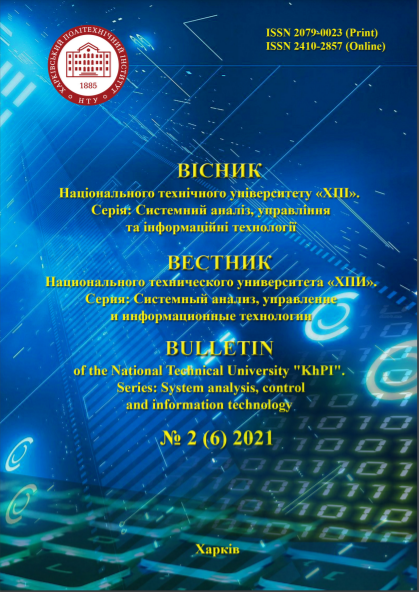MODELING THE DEVELOPMENT OF EPIDEMIS BASED ON INFORMATION TECHNOLOGIES OF OPTIMIZATION
DOI:
https://doi.org/10.20998/2079-0023.2021.02.08Keywords:
epidemic, mathematical model, differential equations, identification, information technology, simulationAbstract
Mathematical models of the epidemic have been developed and researched to predict the development of the COVID-19 coronavirus epidemic on the
basis of information technology for optimizing complex dynamic systems. Mathematical models of epidemics SIR, SIRS, SEIR, SIS, MSEIR in the
form of nonlinear systems of differential equations are considered and the analysis of use of mathematical models for research of development of
epidemic of coronavirus epidemic COVID-19 is carried out. Based on the statistics of the COVID-19 coronavirus epidemic in the Kharkiv region, the
initial values of the parameters of the models of the last wave of the epidemic were calculated. Using these models, the program of the first-degree
system method from the module of information technology integration methods for solving nonlinear systems of differential equations simulated the
development of the last wave of the epidemic. Simulation shows that the number of healthy people will decrease and the number of infected people
will increase. In 12 months, the number of infected people will reach its maximum and then begin to decline. The information technology of
optimization of dynamic systems is used to identify the parameters of the COVID-19 epidemic models on the basis of statistical data on diseases in the
Kharkiv region. Using the obtained models, the development of the last wave of the COVID-19 epidemic in Kharkiv region was predicted. The
processes of epidemic development according to the SIR-model with weakening immunity are given, with the values of the model parameters obtained
as a result of identification. Approximately 13 months after the outbreak of the epidemic, the number of infected people will reach its maximum and
then begin to decline. In 10 months, the entire population of Kharkiv region will be infected. These results will allow us to predict possible options for
the development of the epidemic of coronavirus COVID-19 in the Kharkiv region for the timely implementation of adequate anti-epidemic measures.
References
Kermack W. O., McKendrick A. G. A Contribution to the mathematical theory of epidemics. URL: https://www.jstor.org/stable/94815 (accessed 07.10.2021).
Begon M., Bennett M., Bowers R. G., French N. P. A clarication of transmission terms in host-microparisite models: numbers, densities and areas. https://pubmed.ncbi.nlm.nih.gov/12211582/ (accessed 10.10.2021).
Anderson R., May R. Infectious diseases of humans: dynamics and control. https://www.amazon.com/Infectious-Diseases-HumansDynamics-Control/dp/019854040X (accessed 11.11.2021).
Gray A., Greenhalgh D., Mao X., Pan J. The SIS epidemic model with markovian switching. URL: http://strathprints.strath.ac.uk/41322 (accessed 10.10.2021)
Ivanov M. V. Matematicheskoe modelirovanie processa pandemii: teoriya i praktika [Mathematical modeling of the pandemic process]. Available at: https://indsi.ru/2020/04/30/ mathematicalmodelingprocess / (accessed 20.11.21).
Avilov K. Matematychne modeliuvannia v epidemiolohii yak zavdannia analizu skladnykh danykh. [Mathematical modeling in epidemiology as a problem in the analysis of complex data]. Aviable at: https://indsi.ru/2020/04/30/ математическоемоделированиепроцесса/ (accessed 20.11.2021).
Allen L. J. S. An Introduction to stochastic epidemic models. URL: http://eaton.math.rpi.edu/csums/papers/epidemic/allenstochasticepid emic.pdf (accessed 13.10.2021).
Ivashchenko D. S., Kutsenko O. S. Oglyad i analiz metodov modeluvannya protsesu rozvetku epidemiyi [Overview and analysis of methods for modeling the epidemic development process]. Vestnik Nats. tekhn. un-ta "KhPI": sb. nauch. tr. Temat. vyp.: Sistemnyy analiz, upravlenie i informatsionnye tekhnologii [Bulletin of the National Technical University "KhPI": a collection of scientific papers. Thematic issue: System analysis, management and information technology]. Kharkov, NTU "KhPI" Publ., 2021, no. 1 (5), pp. 16–19.
Nikulina E. N., Severyn V. P., Kotsiuba N. V. Rozrobka informatsiynoi tekhnologii optymizatsii upravlinnya skladnymy dynamichnymy systemamy [Development of information technology for optimizing the control of complex dynamic systems]. Vestnik Nats. tekhn. un-ta "KhPI": sb. nauch. tr. Temat. vyp.: Sistemnyy analiz, upravlenie i informatsionnye tekhnologii [Bulletin of the National Technical University "KhPI": a collection of scientific papers. Thematic issue: System analysis, management and information technology]. Kharkov, NTU "KhPI" Publ., 2020, no. 2 (4), pp. 63–69.
Nikulina O. M., Severyn V. P., Kotsiuba N. V. Modul predstavlennya informatsiyi dlya technologiyi optymizatsiyi system avtomatychnogo upravlinnya [Information presentation module for automatic control systems optimization technology]. Tezy dopovidey ХXVIІ mighnorodnoyi naurovo-praktychnoyi konferentsiyi MicroCAD–2019. Ch. I. [Abstracts of the XXVII International Scientific and Practical Conference "MicroCAD–2019". Vol. 2]. Kharkiv, NTU "KhPI" Publ., 2019, p. 36.
Nikulina E. N., Severyn V. P., Kotsiuba N. V. Identifikatsiya s analiz ustoychivosti konturov avtomaticheskogo regulirovaniya energoblokov AES s reaktorami VVER-1000 [Identification and Analysis of stability of automatic control loops for NPP power units with VVER-1000 reactors.]. Tezy dopovidey ХXV mighnorodnoyi naurovo-praktychnoyi konferentsiyi Avtomatika–2018. [Abstracts of the XXV International Scientific and Practical Conference "Automatics–2018"]. Lviv, Lviv Polytechnic Publ., 2018, pp. 54–55.
Statistics // https://index.minfin.com.ua/reference/ coronavirus/ukraine/harkovskaya/ (accessed 10.11.2021).
Downloads
Published
How to Cite
Issue
Section
License
LicenseAuthors who publish with this journal agree to the following terms:
- Authors retain copyright and grant the journal right of first publication with the work simultaneously licensed under a Creative Commons Attribution License that allows others to share the work with an acknowledgement of the work's authorship and initial publication in this journal.
- Authors are able to enter into separate, additional contractual arrangements for the non-exclusive distribution of the journal's published version of the work (e.g., post it to an institutional repository or publish it in a book), with an acknowledgement of its initial publication in this journal.
- Authors are permitted and encouraged to post their work online (e.g., in institutional repositories or on their website) prior to and during the submission process, as it can lead to productive exchanges, as well as earlier and greater citation of published work (See The Effect of Open Access).


